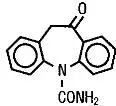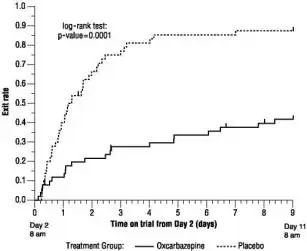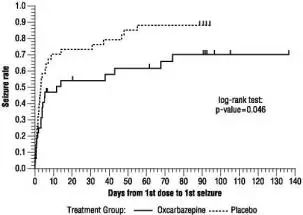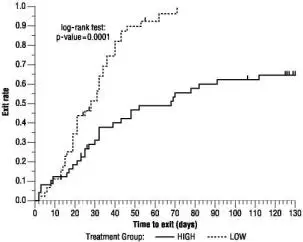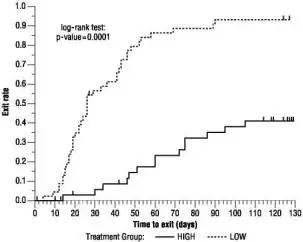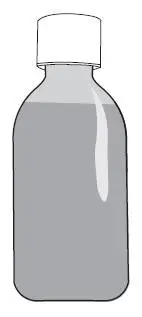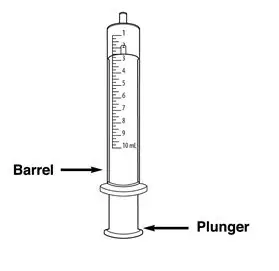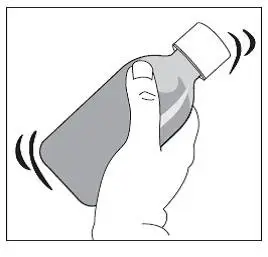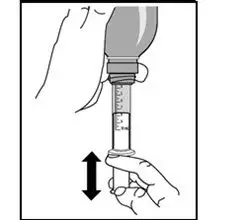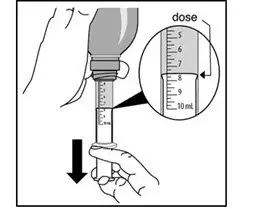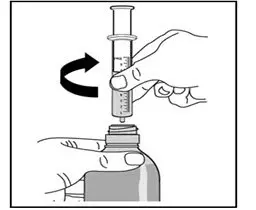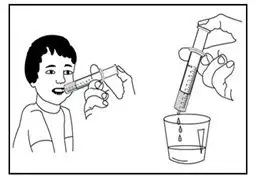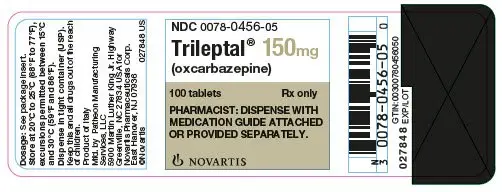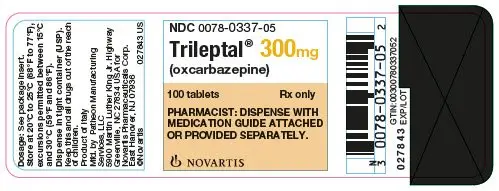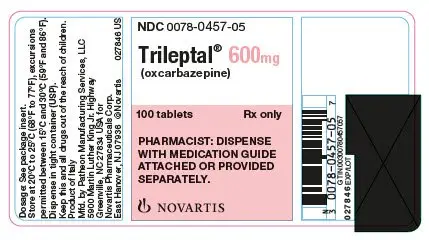Drug Detail:Trileptal (Oxcarbazepine [ ox-kar-bay-zeh-peen ])
Drug Class: Dibenzazepine anticonvulsants
Highlights of Prescribing Information
TRILEPTAL® (oxcarbazepine) film-coated tablets, for oral use
TRILEPTAL® (oxcarbazepine) oral suspension
Initial U.S. Approval: 2000
Indications and Usage for Trileptal
TRILEPTAL is indicated for:
- Adults: Monotherapy or adjunctive therapy in the treatment of partial-onset seizures
- Pediatrics:
- Monotherapy in the treatment of partial-onset seizures in children 4-16 years
- Adjunctive therapy in the treatment of partial-onset seizures in children 2-16 years (1)
Trileptal Dosage and Administration
Adults: initiate with a dose of 600 mg/day, given twice a day
- Adjunctive Therapy: Maximum increment of 600 mg/day at approximately weekly intervals. The recommended daily dose is 1200 mg/day (2.1)
- Conversion to Monotherapy: withdrawal concomitant over 3 to 6 weeks; reach maximum dose of TRILEPTAL in 2 to 4 weeks with increments of 600 mg/day at weekly intervals to a recommended daily dose of 2400 mg/day (2.2)
- Initiation of Monotherapy: Increments of 300 mg/day every third day to a dose of 1200 mg/day (2.3)
- Initiate at one-half the usual starting dose and increase slowly in patients with a creatinine clearance < 30 mL/min (2.7)
Pediatrics: initiation with 8 to 10 mg/kg/day, given twice a day. For patients aged 2 to < 4 years and under 20 kg, a starting dose of 16 to 20 mg/kg/day may be considered. Recommended daily dose is dependent upon patient weight.
- Adjunctive Patients (Aged 2-16 Years): For patients aged 4 to 16 years, target maintenance dose should be achieved over 2 weeks (2.4). For patients aged 2 to < 4 years, maximum maintenance dose should be achieved over 2 to 4 weeks and should not to exceed 60 mg/kg/day (2.4)
- Conversion to Monotherapy for Patients (Aged 4-16 Years): Maximum increment of 10 mg/kg/day at weekly intervals, concomitant antiepileptic drugs (AEDs) can be completely withdrawn over 3 to 6 weeks (2.5)
- Initiation of Monotherapy for Patients (Aged 4-16 Years): Increments of 5 mg/kg/day every third day (2.6)
Dosage Forms and Strengths
- Film-coated tablets: 150 mg, 300 mg and 600 mg (3)
- Oral suspension: 300 mg/5 mL (60 mg/mL) (3)
Contraindications
Known hypersensitivity to oxcarbazepine or to any of its components, or to eslicarbazepine acetate (4, 5.2)
Warnings and Precautions
- Hyponatremia: Monitor serum sodium levels (5.1)
- Cross Hypersensitivity Reaction to Carbamazepine: Discontinue immediately if hypersensitivity occurs (5.3)
- Serious Dermatological Reactions: If occurs, consider discontinuation (5.4)
- Suicidal Behavior and Ideation: Monitor for suicidal thoughts/behavior (5.5)
- Withdrawal of AEDs: Withdraw TRILEPTAL gradually (5.6)
- Cognitive/Neuropsychiatric Adverse Reactions: May cause cognitive dysfunction, somnolence, and coordination abnormalities. Use caution when operating machinery (5.7)
- Drug Reaction with Eosinophilia and Systemic Symptoms (DRESS)/Multi-Organ Hypersensitivity: Monitor and discontinue if another cause cannot be established (5.8)
- Hematologic Events: Consider discontinuing (5.9)
- Seizure Control During Pregnancy: Active metabolite may decrease (5.10)
- Risk of Seizure Aggravation: Discontinue if occurs (5.11)
Adverse Reactions/Side Effects
The most common (≥ 10% more than placebo for adjunctive or low dose for monotherapy) adverse reactions in adults and pediatrics were: dizziness, somnolence, diplopia, fatigue, nausea, vomiting, ataxia, abnormal vision, headache, nystagmus, tremor, and abnormal gait (6.1)
To report SUSPECTED ADVERSE REACTIONS, contact Novartis Pharmaceuticals Corporation at 1-888-669-6682 or FDA at 1-800-FDA-1088 or www.fda.gov/medwatch.
Drug Interactions
- Phenytoin: Increased phenytoin levels. Reduced dose of phenytoin may be required (7.1)
- Carbamazepine, Phenytoin, and Phenobarbital: Decreased plasma levels of MHD (the active metabolite). Dose adjustments may be necessary (7.1)
- Oral Contraceptive: TRILEPTAL may decrease the effectiveness of hormonal contraceptives (7.3)
Use In Specific Populations
- Pregnancy: May cause fetal harm (8.1)
See 17 for PATIENT COUNSELING INFORMATION and Medication Guide.
Revised: 5/2020
Related/similar drugs
gabapentin, clonazepam, pregabalin, lamotrigine, Lyrica, diazepam, topiramateFull Prescribing Information
1. Indications and Usage for Trileptal
TRILEPTAL is indicated for use as monotherapy or adjunctive therapy in the treatment of partial-onset seizures in adults and as monotherapy in the treatment of partial-onset seizures in pediatric patients aged 4 years and above, and as adjunctive therapy in pediatric patients aged 2 years and above with partial-onset seizures.
2. Trileptal Dosage and Administration
2.1 Adjunctive Therapy for Adults
Initiate TRILEPTAL with a dose of 600 mg/day, given twice a day. If clinically indicated, the dose may be increased by a maximum of 600 mg/day at approximately weekly intervals; the maximum recommended daily dose is 1200 mg/day. Daily doses above 1200 mg/day show somewhat greater effectiveness in controlled trials, but most patients were not able to tolerate the 2400 mg/day dose, primarily because of central nervous (CNS) effects.
Dosage adjustment is recommended with concomitant use of strong CYP3A4 enzyme inducers or UGT inducers, which include certain antiepileptic drugs (AEDs) [see Drug Interactions (7.1, 7.2)].
2.2 Conversion to Monotherapy for Adults
Patients receiving concomitant AEDs may be converted to monotherapy by initiating treatment with TRILEPTAL at 600 mg/day (given in a twice a day regimen) while simultaneously initiating the reduction of the dose of the concomitant AEDs. The concomitant AEDs should be completely withdrawn over 3 to 6 weeks, while the maximum dose of TRILEPTAL should be reached in about 2 to 4 weeks. TRILEPTAL may be increased as clinically indicated by a maximum increment of 600 mg/day at approximately weekly intervals to achieve the maximum recommended daily dose of 2400 mg/day. A daily dose of 1200 mg/day has been shown in one study to be effective in patients in whom monotherapy has been initiated with TRILEPTAL. Patients should be observed closely during this transition phase.
2.3 Initiation of Monotherapy for Adults
Patients not currently being treated with AEDs may have monotherapy initiated with TRILEPTAL. In these patients, initiate TRILEPTAL at a dose of 600 mg/day (given a twice a day); the dose should be increased by 300 mg/day every third day to a dose of 1200 mg/day. Controlled trials in these patients examined the effectiveness of a 1200 mg/day dose; a dose of 2400 mg/day has been shown to be effective in patients converted from other AEDs to TRILEPTAL monotherapy (see above).
2.4 Adjunctive Therapy for Pediatric Patients (Aged 2-16 Years)
In pediatric patients aged 4-16 years, initiate TRILETPAL at a daily dose of 8 to 10 mg/kg generally not to exceed 600 mg/day, given twice a day. The target maintenance dose of TRILEPTAL should be achieved over 2 weeks, and is dependent upon patient weight, according to the following chart:
20 to 29 kg-900 mg/day
29.1 to 39 kg-1200 mg/day
> 39 kg-1800 mg/day
In the clinical trial, in which the intention was to reach these target doses, the median daily dose was 31 mg/kg with a range of 6 to 51 mg/kg.
In pediatric patients aged 2 to < 4 years, initiate TRILEPTAL at a daily dose of 8 to 10 mg/kg generally not to exceed 600 mg/day, given twice a day. For patients less than 20 kg, a starting dose of 16 to 20 mg/kg may be considered [see Clinical Pharmacology (12.3)]. The maximum maintenance dose of TRILEPTAL should be achieved over 2 to 4 weeks and should not exceed 60 mg/kg/day in a twice a day regimen.
In the clinical trial in pediatric patients (2 to 4 years of age), in which the intention was to reach the target dose of 60 mg/kg/day, 50% of patients reached a final dose of at least 55 mg/kg/day.
Under adjunctive therapy (with and without enzyme-inducing AEDs), when normalized by body weight, apparent clearance (L/hr/kg) decreased when age increased such that children 2 to < 4 years of age may require up to twice the oxcarbazepine dose per body weight compared to adults; and children 4 to ≤ 12 years of age may require a 50% higher oxcarbazepine dose per body weight compared to adults.
Dosage adjustment is recommended with concomitant use of strong CYP3A4 enzyme inducers or UGT inducers, which include certain AEDs [see Drug Interactions (7.1, 7.2)].
2.5 Conversion to Monotherapy for Pediatric Patients (Aged 4-16 Years)
Patients receiving concomitant AEDs may be converted to monotherapy by initiating treatment with TRILEPTAL at approximately 8 to 10 mg/kg/day given twice a day, while simultaneously initiating the reduction of the dose of the concomitant AEDs. The concomitant AEDs can be completely withdrawn over 3 to 6 weeks, while TRILEPTAL may be increased as clinically indicated by a maximum increment of 10 mg/kg/day at approximately weekly intervals to achieve the recommended daily dose. Patients should be observed closely during this transition phase.
The recommended total daily dose of TRILEPTAL is shown in Table 1.
2.6 Initiation of Monotherapy for Pediatric Patients (Aged 4-16 Years)
Patients not currently being treated with AEDs may have monotherapy initiated with TRILEPTAL. In these patients, initiate TRILEPTAL at a dose of 8 to 10 mg/kg/day given twice a day. The dose should be increased by 5 mg/kg/day every third day to the recommended daily dose shown in the table below.
| From | To | |
| Weight in kg | Dose (mg/day) | Dose (mg/day) |
| 20 | 600 | 900 |
| 25 | 900 | 1200 |
| 30 | 900 | 1200 |
| 35 | 900 | 1500 |
| 40 | 900 | 1500 |
| 45 | 1200 | 1500 |
| 50 | 1200 | 1800 |
| 55 | 1200 | 1800 |
| 60 | 1200 | 2100 |
| 65 | 1200 | 2100 |
| 70 | 1500 | 2100 |
2.7 Dosage Modification for Patients With Renal Impairment
In patients with impaired renal function (creatinine clearance < 30 mL/min), initiate TRILEPTAL at one-half the usual starting dose (300 mg/day, given twice a day), and increase slowly to achieve the desired clinical response [see Clinical Pharmacology (12.3)].
3. Dosage Forms and Strengths
Film-coated Tablets:
- 150 mg: pale grey-green, ovaloid, slightly biconvex, scored on both sides. Imprinted with T/D on one side and C/G on the other side.
- 300 mg: yellow, ovaloid, slightly biconvex, scored on both sides. Imprinted with TE/TE on one side and CG/CG on the other side.
- 600 mg: light pink, ovaloid, slightly biconvex, scored on both sides. Imprinted with TF/TF on one side and CG/CG on the other side.
Oral Suspension:
- 300 mg/5 mL (60 mg/mL): off-white to slightly brown or slightly red suspension.
4. Contraindications
TRILEPTAL is contraindicated in patients with a known hypersensitivity to oxcarbazepine or to any of its components, or to eslicarbazepine acetate [see Warnings and Precautions (5.2, 5.3)].
5. Warnings and Precautions
5.1 Hyponatremia
Clinically significant hyponatremia (sodium < 125 mmol/L) can develop during TRILEPTAL use. In the 14 controlled epilepsy studies, 2.5% of TRILEPTAL-treated patients (38/1524) had a sodium of less than 125 mmol/L at some point during treatment, compared to no such patients assigned placebo or active control (carbamazepine and phenobarbital for adjunctive and monotherapy substitution studies, and phenytoin and valproate for the monotherapy initiation studies). Clinically significant hyponatremia generally occurred during the first 3 months of treatment with TRILEPTAL, although there were patients who first developed a serum sodium < 125 mmol/L more than 1 year after initiation of therapy. Most patients who developed hyponatremia were asymptomatic, but patients in the clinical trials were frequently monitored and some had their TRILEPTAL dose reduced, discontinued, or had their fluid intake restricted for hyponatremia. Whether or not these maneuvers prevented the occurrence of more severe events is unknown. Cases of symptomatic hyponatremia and syndrome of inappropriate antidiuretic hormone secretion (SIADH) have been reported during postmarketing use. In clinical trials, patients whose treatment with TRILEPTAL was discontinued due to hyponatremia generally experienced normalization of serum sodium within a few days without additional treatment.
Measurement of serum sodium levels should be considered for patients during maintenance treatment with TRILEPTAL, particularly if the patient is receiving other medications known to decrease serum sodium levels (e.g., drugs associated with inappropriate ADH secretion), or if symptoms possibly indicating hyponatremia develop (e.g., nausea, malaise, headache, lethargy, confusion, obtundation, or increase in seizure frequency or severity).
5.2 Anaphylactic Reactions and Angioedema
Rare cases of anaphylaxis and angioedema involving the larynx, glottis, lips and eyelids have been reported in patients after taking the first or subsequent doses of TRILEPTAL. Angioedema associated with laryngeal edema can be fatal. If a patient develops any of these reactions after treatment with TRILEPTAL, the drug should be discontinued and an alternative treatment started. These patients should not be rechallenged with the drug [see Warnings and Precautions (5.3)].
5.3 Cross Hypersensitivity Reaction to Carbamazepine
Approximately 25% to 30% of patients who have had hypersensitivity reactions to carbamazepine will experience hypersensitivity reactions with TRILEPTAL. For this reason, patients should be specifically questioned about any prior experience with carbamazepine, and patients with a history of hypersensitivity reactions to carbamazepine should ordinarily be treated with TRILEPTAL only if the potential benefit justifies the potential risk. If signs or symptoms of hypersensitivity develop, TRILEPTAL should be discontinued immediately [see Warnings and Precautions (5.2, 5.8)].
5.4 Serious Dermatological Reactions
Serious dermatological reactions, including Stevens-Johnson syndrome (SJS) and toxic epidermal necrolysis (TEN), have been reported in both children and adults in association with TRILEPTAL use. Such serious skin reactions may be life threatening, and some patients have required hospitalization with very rare reports of fatal outcome. The median time of onset for reported cases was 19 days after treatment initiation. Recurrence of the serious skin reactions following rechallenge with TRILEPTAL has also been reported.
The reporting rate of TEN and SJS associated with TRILEPTAL use, which is generally accepted to be an underestimate due to underreporting, exceeds the background incidence rate estimates by a factor of 3- to 10-fold. Estimates of the background incidence rate for these serious skin reactions in the general population range between 0.5 to 6 cases per million-person years. Therefore, if a patient develops a skin reaction while taking TRILEPTAL, consideration should be given to discontinuing TRILEPTAL use and prescribing another antiepileptic medication.
Association With HLAB*1502
Patients carrying the HLA-B*1502 allele may be at increased risk for SJS/TEN with Trileptal treatment. Human Leukocyte Antigen (HLA) allele B*1502 increases the risk for developing SJS/TEN in patients treated with carbamazepine. The chemical structure of TRILEPTAL is similar to that of carbamazepine. Available clinical evidence, and data from nonclinical studies showing a direct interaction between TRILEPTAL and HLA-B*1502 protein, suggest that the HLA-B*1502 allele may also increase the risk for SJS/TEN with TRILEPTAL.
The frequency of HLA-B*1502 allele ranges from 2% to 12% in Han Chinese populations, is about 8% in Thai populations, and above 15% in the Philippines, and in some Malaysian populations. Allele frequencies up to about 2% and 6% have been reported in Korea and India, respectively. The frequency of the HLA-B*1502 allele is negligible in people from European descent, several African populations, indigenous peoples of the Americas, Hispanic populations, and in Japanese (< 1%).
Testing for the presence of the HLA-B*1502 allele should be considered in patients with ancestry in genetically at-risk populations, prior to initiating treatment with TRILEPTAL. The use of TRILEPTAL should be avoided in patients positive for HLA-B*1502 unless the benefits clearly outweigh the risks. Consideration should also be given to avoid the use of other drugs associated with SJS/TEN in HLA-B*1502 positive patients, when alternative therapies are otherwise equally acceptable. Screening is not generally recommended in patients from populations in which the prevalence of HLA-B*1502 is low, or in current TRILEPTAL users, as the risk of SJS/TEN is largely confined to the first few months of therapy, regardless of HLA-B*1502 status.
The use of HLA-B*1502 genotyping has important limitations, and must never substitute for appropriate clinical vigilance and patient management. The role of other possible factors in the development of, and morbidity from, SJS/TEN, such as AED dose, compliance, concomitant medications, comorbidities, and the level of dermatologic monitoring have not been well characterized.
5.5 Suicidal Behavior and Ideation
Antiepileptic drugs, including TRILEPTAL, increase the risk of suicidal thoughts or behavior in patients taking these drugs for any indication. Patients treated with any AED for any indication should be monitored for the emergence or worsening of depression, suicidal thoughts or behavior, and/or any unusual changes in mood or behavior.
Pooled analyses of 199 placebo-controlled clinical trials (mono- and adjunctive therapy) of 11 different AEDs showed that patients randomized to one of the AEDs had approximately twice the risk (adjusted Relative Risk 1.8, 95% CI:1.2, 2.7) of suicidal thinking or behavior compared to patients randomized to placebo. In these trials, which had a median treatment duration of 12 weeks, the estimated incidence rate of suicidal behavior or ideation among 27,863 AED-treated patients was 0.43%, compared to 0.24% among 16,029 placebo-treated patients, representing an increase of approximately one case of suicidal thinking or behavior for every 530 patients treated. There were 4 suicides in drug-treated patients in the trials and none in placebo-treated patients, but the number is too small to allow any conclusion about drug effect on suicide.
The increased risk of suicidal thoughts or behavior with AEDs was observed as early as one week after starting drug treatment with AEDs, and persisted for the duration of treatment assessed. Because most trials included in the analysis did not extend beyond 24 weeks, the risk of suicidal thoughts or behavior beyond 24 weeks could not be assessed.
The risk of suicidal thoughts or behavior was generally consistent among drugs in the data analyzed. The finding of increased risk with AEDs of varying mechanisms of action and across a range of indications suggests that the risk applies to all AEDs used for any indication. The risk did not vary substantially by age (5 to 100 years) in the clinical trials analyzed. Table 2 shows absolute and relative risk by indication for all evaluated AEDs.
| Indication | Placebo Patients With Events Per 1000 Patients
| Drug Patients With Events Per 1000 Patients | Relative Risk: Incidence of Events in Drug Patients/Incidence in Placebo Patients | Risk Difference: Additional Drug Patients With Events Per 1000 Patients |
| Epilepsy | 1.0 | 3.4 | 3.5 | 2.4 |
| Psychiatric | 5.7 | 8.5 | 1.5 | 2.9 |
| Other | 1.0 | 1.8 | 1.9 | 0.9 |
| Total | 2.4 | 4.3 | 1.8 | 1.9 |
The relative risk for suicidal thoughts or behavior was higher in clinical trials for epilepsy than in clinical trials for psychiatric or other conditions, but the absolute risk differences were similar for the epilepsy and psychiatric indications.
Anyone considering prescribing TRILEPTAL or any other AED must balance the risk of suicidal thoughts or behavior with the risk of untreated illness. Epilepsy and many other illnesses for which AEDs are prescribed are themselves associated with morbidity and mortality and an increased risk of suicidal thoughts and behavior. Should suicidal thoughts and behavior emerge during treatment, the prescriber needs to consider whether the emergence of these symptoms in any given patient may be related to the illness being treated.
Patients, their caregivers, and families should be informed that AEDs increase the risk of suicidal thoughts and behavior and should be advised of the need to be alert for the emergence or worsening of the signs and symptoms of depression, any unusual changes in mood or behavior, or the emergence of suicidal thoughts, behavior, or thoughts about self-harm. Behaviors of concern should be reported immediately to healthcare providers.
5.6 Withdrawal of Antiepileptic Drugs
As with most AEDs, TRILEPTAL should generally be withdrawn gradually because of the risk of increased seizure frequency and status epilepticus [see Dosage and Administration (2.4) and Clinical Studies (14)]. But if withdrawal is needed because of a serious adverse event, rapid discontinuation can be considered.
5.7 Cognitive/Neuropsychiatric Adverse Reactions
Use of TRILEPTAL has been associated with CNS-related adverse reactions. The most significant of these can be classified into three general categories: 1) cognitive symptoms, including psychomotor slowing, difficulty with concentration, and speech or language problems; 2) somnolence or fatigue; and 3) coordination abnormalities, including ataxia and gait disturbances.
Patients should be monitored for these signs and symptoms and advised not to drive or operate machinery until they have gained sufficient experience on TRILEPTAL to gauge whether it adversely affects their ability to drive or operate machinery.
Adult Patients
In one large, fixed-dose study, TRILEPTAL was added to existing AED therapy (up to three concomitant AEDs). By protocol, the dosage of the concomitant AEDs could not be reduced as TRILEPTAL was added, reduction in TRILEPTAL dosage was not allowed if intolerance developed, and patients were discontinued if unable to tolerate their highest target maintenance doses. In this trial, 65% of patients were discontinued because they could not tolerate the 2400 mg/day dose of TRILEPTAL on top of existing AEDs. The adverse events seen in this study were primarily CNS related and the risk for discontinuation was dose related.
In this trial, 7.1% of oxcarbazepine-treated patients and 4% of placebo-treated patients experienced a cognitive adverse reaction. The risk of discontinuation for these events was about 6.5 times greater on oxcarbazepine than on placebo. In addition, 26% of oxcarbazepine-treated patients and 12% of placebo-treated patients experienced somnolence. The risk of discontinuation for somnolence was about 10 times greater on oxcarbazepine than on placebo. Finally, 28.7% of oxcarbazepine-treated patients and 6.4% of placebo-treated patients experienced ataxia or gait disturbances. The risk for discontinuation for these events was about 7 times greater on oxcarbazepine than on placebo.
In a single placebo-controlled monotherapy trial evaluating 2400 mg/day of TRILEPTAL, no patients in either treatment group discontinued double-blind treatment because of cognitive adverse events, somnolence, ataxia, or gait disturbance.
In the 2 dose-controlled conversion to monotherapy trials comparing 2400 mg/day and 300 mg/day TRILEPTAL, 1.1% of patients in the 2400 mg/day group discontinued double-blind treatment because of somnolence or cognitive adverse reactions compared to 0% in the 300 mg/day group. In these trials, no patients discontinued because of ataxia or gait disturbances in either treatment group.
Pediatric Patients
A study was conducted in pediatric patients (3 to 17 years old) with inadequately controlled partial-onset seizures in which TRILEPTAL was added to existing AED therapy (up to 2 concomitant AEDs). By protocol, the dosage of concomitant AEDs could not be reduced as TRILEPTAL was added. TRILEPTAL was titrated to reach a target dose ranging from 30 mg/kg to 46 mg/kg (based on a patient’s body weight with fixed doses for predefined weight ranges).
Cognitive adverse events occurred in 5.8% of oxcarbazepine-treated patients (the single most common event being concentration impairment, 4 of 138 patients) and in 3.1% of patients treated with placebo. In addition, 34.8% of oxcarbazepine-treated patients and 14.0% of placebo-treated patients experienced somnolence (no patient discontinued due to a cognitive adverse reaction or somnolence). Finally, 23.2% of oxcarbazepine-treated patients and 7.0% of placebo-treated patients experienced ataxia or gait disturbances. Two (1.4%) oxcarbazepine-treated patients and 1 (0.8%) placebo-treated patient discontinued due to ataxia or gait disturbances.
5.8 Drug Reaction With Eosinophilia and Systemic Symptoms/Multi-Organ Hypersensitivity
Drug Reaction with Eosinophilia and Systemic Symptoms (DRESS), also known as multi-organ hypersensitivity, has occurred with TRILEPTAL. Some of these events have been fatal or life-threatening. DRESS typically, although not exclusively, presents with fever, rash, lymphadenopathy and/or facial swelling, in association with other organ system involvement, such as hepatitis, nephritis, hematologic abnormalities, myocarditis, or myositis sometimes resembling an acute viral infection. Eosinophilia is often present. This disorder is variable in its expression, and other organ systems not noted here may be involved. It is important to note that early manifestations of hypersensitivity (e.g., fever, lymphadenopathy) may be present even though rash is not evident. If such signs or symptoms are present, the patient should be evaluated immediately. TRILEPTAL should be discontinued if an alternative etiology for the signs or symptoms cannot be established.
5.9 Hematologic Events
Rare reports of pancytopenia, agranulocytosis, and leukopenia have been seen in patients treated with TRILEPTAL during postmarketing experience. Discontinuation of the drug should be considered if any evidence of these hematologic events develops.
5.10 Seizure Control During Pregnancy
Due to physiological changes during pregnancy, plasma levels of the active metabolite of oxcarbazepine, the 10-monohydroxy derivative (MHD), may gradually decrease throughout pregnancy. It is recommended that patients be monitored carefully during pregnancy. Close monitoring should continue through the postpartum period because MHD levels may return after delivery.
5.11 Risk of Seizure Aggravation
Exacerbation of or new onset primary generalized seizures has been reported with TRILEPTAL. The risk of aggravation of primary generalized seizures is seen especially in children but may also occur in adults. In case of seizure aggravation, TRILEPTAL should be discontinued.
6. Adverse Reactions/Side Effects
The following serious adverse reactions are described below and elsewhere in the labeling:
- Hyponatremia [see Warnings and Precautions (5.1)]
- Anaphylactic Reactions and Angioedema [see Warnings and Precautions (5.2)]
- Cross Hypersensitivity Reaction to Carbamazepine [see Warnings and Precautions (5.3)]
- Serious Dermatological Reactions [see Warnings and Precautions (5.4)]
- Suicidal Behavior and Ideation [see Warnings and Precautions (5.5)]
- Cognitive/Neuropsychiatric Adverse Reactions [see Warnings and Precautions (5.7)]
- Drug Reaction with Eosinophilia and Systemic Symptoms (DRESS)/Multi-Organ Hypersensitivity [see Warnings and Precautions (5.8)]
- Hematologic Events [see Warnings and Precautions (5.9)]
6.1 Clinical Trials Experience
Because clinical trials are conducted under widely varying conditions, adverse reaction rates observed in the clinical trials of a drug cannot be directly compared to rates in the clinical trials of another drug and may not reflect the rates observed in practice.
Most Common Adverse Reactions in All Clinical Studies
Adjunctive Therapy/Monotherapy in Adults Previously Treated With Other AEDs
The most common (≥ 10% more than placebo for adjunctive or low dose for monotherapy) adverse reactions with TRILEPTAL: dizziness, somnolence, diplopia, fatigue, nausea, vomiting, ataxia, abnormal vision, headache, nystagmus tremor, and abnormal gait.
Approximately 23% of these 1537 adult patients discontinued treatment because of an adverse reaction. The adverse reactions most commonly associated with discontinuation were: dizziness (6.4%), diplopia (5.9%), ataxia (5.2%), vomiting (5.1%), nausea (4.9%), somnolence (3.8%), headache (2.9%), fatigue (2.1%), abnormal vision (2.1%), tremor (1.8%), abnormal gait (1.7%), rash (1.4%), and hyponatremia (1.0%).
Monotherapy in Adults Not Previously Treated With Other AEDs
The most common (≥ 5%) adverse reactions with TRILEPTAL in these patients were similar to those in previously treated patients.
Approximately 9% of these 295 adult patients discontinued treatment because of an adverse reaction. The adverse reactions most commonly associated with discontinuation were: dizziness (1.7%), nausea (1.7%), rash (1.7%), and headache (1.4%).
Adjunctive Therapy/Monotherapy in Pediatric Patients 4 Years Old and Above Previously Treated With Other AEDs
The most common (≥ 5%) adverse reactions with TRILEPTAL in these patients were similar to those seen in adults.
Approximately 11% of these 456 pediatric patients discontinued treatment because of an adverse reaction. The adverse reactions most commonly associated with discontinuation were: somnolence (2.4%), vomiting (2.0%), ataxia (1.8%), diplopia (1.3%), dizziness (1.3%), fatigue (1.1%), and nystagmus (1.1%).
Monotherapy in Pediatric Patients 4 Years Old and Above Not Previously Treated With Other AEDs
The most common (≥ 5%) adverse reactions with TRILEPTAL in these patients were similar to those in adults.
Approximately 9.2% of 152 pediatric patients discontinued treatment because of an adverse reaction. The adverse reactions most commonly associated (≥ 1%) with discontinuation were rash (5.3%) and maculopapular rash (1.3%).
Adjunctive Therapy/Monotherapy in Pediatric Patients 1 Month to < 4 Years Old Previously Treated or Not Previously Treated with Other AEDs:
The most common (≥ 5%) adverse reactions with TRILEPTAL in these patients were similar to those seen in older children and adults except for infections and infestations which were more frequently seen in these younger children.
Approximately 11% of these 241 pediatric patients discontinued treatment because of an adverse reaction. The adverse reactions most commonly associated with discontinuation were: convulsions (3.7%), status epilepticus (1.2%), and ataxia (1.2%).
Controlled Clinical Studies of Adjunctive Therapy/Monotherapy in Adults Previously Treated With Other AEDs
Table 3 lists adverse reactions that occurred in at least 2% of adult patients with epilepsy, treated with TRILEPTAL or placebo as adjunctive treatment and were numerically more common in the patients treated with any dose of TRILEPTAL.
Table 4 lists adverse reactions in patients converted from other AEDs to either high-dose TRILEPTAL (2400 mg/day) or low-dose (300 mg/day) TRILEPTAL. Note that in some of these monotherapy studies patients who dropped out during a preliminary tolerability phase are not included in the tables.
| TRILEPTAL Dosage (mg/day) | ||||
| Body System/
Adverse Reaction | TRILEPTAL 600
N = 163 % | TRILEPTAL
1200 N = 171 % | TRILEPTAL
2400 N = 126 % | Placebo
N = 166 % |
| Body as a Whole | ||||
| Fatigue | 15 | 12 | 15 | 7 |
| Asthenia | 6 | 3 | 6 | 5 |
| Leg Edema | 2 | 1 | 2 | 1 |
| Increased Weight | 1 | 2 | 2 | 1 |
| Feeling Abnormal | 0 | 1 | 2 | 0 |
| Cardiovascular System | ||||
| Hypotension | 0 | 1 | 2 | 0 |
| Digestive System | ||||
| Nausea | 15 | 25 | 29 | 10 |
| Vomiting | 13 | 25 | 36 | 5 |
| Abdominal Pain | 10 | 13 | 11 | 5 |
| Diarrhea | 5 | 6 | 7 | 6 |
| Dyspepsia | 5 | 5 | 6 | 2 |
| Constipation | 2 | 2 | 6 | 4 |
| Gastritis | 2 | 1 | 2 | 1 |
| Metabolic and Nutritional Disorders | ||||
| Hyponatremia | 3 | 1 | 2 | 1 |
| Musculoskeletal System | ||||
| Muscle Weakness | 1 | 2 | 2 | 0 |
| Sprains and Strains | 0 | 2 | 2 | 1 |
| Nervous System | ||||
| Headache | 32 | 28 | 26 | 23 |
| Dizziness | 26 | 32 | 49 | 13 |
| Somnolence | 20 | 28 | 36 | 12 |
| Ataxia | 9 | 17 | 31 | 5 |
| Nystagmus | 7 | 20 | 26 | 5 |
| Abnormal Gait | 5 | 10 | 17 | 1 |
| Insomnia | 4 | 2 | 3 | 1 |
| Tremor | 3 | 8 | 16 | 5 |
| Nervousness | 2 | 4 | 2 | 1 |
| Agitation | 1 | 1 | 2 | 1 |
| Abnormal Coordination | 1 | 3 | 2 | 1 |
| Abnormal EEG | 0 | 0 | 2 | 0 |
| Speech Disorder | 1 | 1 | 3 | 0 |
| Confusion | 1 | 1 | 2 | 1 |
| Cranial Injury NOS | 1 | 0 | 2 | 1 |
| Dysmetria | 1 | 2 | 3 | 0 |
| Abnormal Thinking | 0 | 2 | 4 | 0 |
| Respiratory System | ||||
| Rhinitis | 2 | 4 | 5 | 4 |
| Skin and Appendages | ||||
| Acne | 1 | 2 | 2 | 0 |
| Special Senses | ||||
| Diplopia | 14 | 30 | 40 | 5 |
| Vertigo | 6 | 12 | 15 | 2 |
| Abnormal Vision | 6 | 14 | 13 | 4 |
| Abnormal Accommodation | 0 | 0 | 2 | 0 |
| Body System/
Adverse Reaction | TRILEPTAL
2400 mg/day N = 86 % | TRILEPTAL
300 mg/day N = 86 % |
| Body as a Whole | ||
| Fatigue | 21 | 5 |
| Fever | 3 | 0 |
| Allergy | 2 | 0 |
| Generalized Edema | 2 | 1 |
| Chest Pain | 2 | 0 |
| Digestive System | ||
| Nausea | 22 | 7 |
| Vomiting | 15 | 5 |
| Diarrhea | 7 | 5 |
| Dyspepsia | 6 | 1 |
| Anorexia | 5 | 3 |
| Abdominal Pain | 5 | 3 |
| Dry Mouth | 3 | 0 |
| Hemorrhage Rectum | 2 | 0 |
| Toothache | 2 | 1 |
| Hemic and Lymphatic System | ||
| Lymphadenopathy | 2 | 0 |
| Infections and Infestations | ||
| Viral Infection | 7 | 5 |
| Infection | 2 | 0 |
| Metabolic and Nutritional Disorders | ||
| Hyponatremia | 5 | 0 |
| Thirst | 2 | 0 |
| Nervous System | ||
| Headache | 31 | 15 |
| Dizziness | 28 | 8 |
| Somnolence | 19 | 5 |
| Anxiety | 7 | 5 |
| Ataxia | 7 | 1 |
| Confusion | 7 | 0 |
| Nervousness | 7 | 0 |
| Insomnia | 6 | 3 |
| Tremor | 6 | 3 |
| Amnesia | 5 | 1 |
| Aggravated Convulsions | 5 | 2 |
| Emotional Lability | 3 | 2 |
| Hypoesthesia | 3 | 1 |
| Abnormal Coordination | 2 | 1 |
| Nystagmus | 2 | 0 |
| Speech Disorder | 2 | 0 |
| Respiratory System | ||
| Upper Respiratory Tract Infection | 10 | 5 |
| Coughing | 5 | 0 |
| Bronchitis | 3 | 0 |
| Pharyngitis | 3 | 0 |
| Skin and Appendages | ||
| Hot Flushes | 2 | 1 |
| Purpura | 2 | 0 |
| Special Senses | ||
| Abnormal Vision | 14 | 2 |
| Diplopia | 12 | 1 |
| Taste Perversion | 5 | 0 |
| Vertigo | 3 | 0 |
| Earache | 2 | 1 |
| Ear Infection NOS | 2 | 0 |
| Urogenital and Reproductive System | ||
| Urinary Tract Infection | 5 | 1 |
| Micturition Frequency | 2 | 1 |
| Vaginitis | 2 | 0 |
Controlled Clinical Study of Monotherapy in Adults Not Previously Treated With Other AEDs
Table 5 lists adverse reactions in a controlled clinical study of monotherapy in adults not previously treated with other AEDs that occurred in at least 2% of adult patients with epilepsy treated with TRILEPTAL or placebo and were numerically more common in the patients treated with TRILEPTAL.
| Body System/
Adverse Reaction | TRILEPTAL
N = 55 % | Placebo
N = 49 % |
| Body as a Whole | ||
| Falling Down NOS | 4 | 0 |
| Digestive System | ||
| Nausea | 16 | 12 |
| Diarrhea | 7 | 2 |
| Vomiting | 7 | 6 |
| Constipation | 5 | 0 |
| Dyspepsia | 5 | 4 |
| Musculoskeletal System | ||
| Back Pain | 4 | 2 |
| Nervous System | ||
| Dizziness | 22 | 6 |
| Headache | 13 | 10 |
| Ataxia | 5 | 0 |
| Nervousness | 5 | 2 |
| Amnesia | 4 | 2 |
| Abnormal Coordination | 4 | 2 |
| Tremor | 4 | 0 |
| Respiratory System | ||
| Upper Respiratory Tract Infection | 7 | 0 |
| Epistaxis | 4 | 0 |
| Infection Chest | 4 | 0 |
| Sinusitis | 4 | 2 |
| Skin and Appendages | ||
| Rash | 4 | 2 |
| Special Senses | ||
| Vision Abnormal | 4 | 0 |
Controlled Clinical Studies of Adjunctive Therapy/Monotherapy in Pediatric Patients Previously Treated With Other AEDs
Table 6 lists adverse reactions that occurred in at least 2% of pediatric patients with epilepsy treated with TRILEPTAL or placebo as adjunctive treatment and were numerically more common in the patients treated with TRILEPTAL.
| Body System/
Adverse Reaction | TRILEPTAL
N = 171 % | Placebo
N = 139 % |
| Body as a Whole | ||
| Fatigue | 13 | 9 |
| Allergy | 2 | 0 |
| Asthenia | 2 | 1 |
| Digestive System | ||
| Vomiting | 33 | 14 |
| Nausea | 19 | 5 |
| Constipation | 4 | 1 |
| Dyspepsia | 2 | 0 |
| Nervous System | ||
| Headache | 31 | 19 |
| Somnolence | 31 | 13 |
| Dizziness | 28 | 8 |
| Ataxia | 13 | 4 |
| Nystagmus | 9 | 1 |
| Emotional Lability | 8 | 4 |
| Abnormal Gait | 8 | 3 |
| Tremor | 6 | 4 |
| Speech Disorder | 3 | 1 |
| Impaired Concentration | 2 | 1 |
| Convulsions | 2 | 1 |
| Involuntary Muscle Contractions | 2 | 1 |
| Respiratory System | ||
| Rhinitis | 10 | 9 |
| Pneumonia | 2 | 1 |
| Skin and Appendages | ||
| Bruising | 4 | 2 |
| Increased Sweating | 3 | 0 |
| Special Senses | ||
| Diplopia | 17 | 1 |
| Abnormal Vision | 13 | 1 |
| Vertigo | 2 | 0 |
Other Events Observed in Association With the Administration of TRILEPTAL
In the paragraphs that follow, the adverse reactions, other than those in the preceding tables or text, that occurred in a total of 565 children and 1574 adults exposed to TRILEPTAL and that are reasonably likely to be related to drug use are presented. Events common in the population, events reflecting chronic illness and events likely to reflect concomitant illness are omitted particularly if minor. They are listed in order of decreasing frequency. Because the reports cite events observed in open label and uncontrolled trials, the role of TRILEPTAL in their causation cannot be reliably determined.
Body as a Whole: fever, malaise, pain chest precordial, rigors, weight decrease
Cardiovascular System: bradycardia, cardiac failure, cerebral hemorrhage, hypertension, hypotension postural, palpitation, syncope, tachycardia
Digestive System: appetite increased, blood in stool, cholelithiasis, colitis, duodenal ulcer, dysphagia, enteritis, eructation, esophagitis, flatulence, gastric ulcer, gingival bleeding, gum hyperplasia, hematemesis, hemorrhage rectum, hemorrhoids, hiccup, mouth dry, pain biliary, pain right hypochondrium, retching, sialoadenitis, stomatitis, stomatitis ulcerative
Hematologic and Lymphatic System: thrombocytopenia
Laboratory Abnormality: gamma-GT increased, hyperglycemia, hypocalcemia, hypoglycemia, hypokalemia, liver enzymes elevated, serum transaminase increased
Musculoskeletal System: hypertonia muscle
Nervous System: aggressive reaction, amnesia, anguish, anxiety, apathy, aphasia, aura, convulsions aggravated, delirium, delusion, depressed level of consciousness, dysphonia, dystonia, emotional lability, euphoria, extrapyramidal disorder, feeling drunk, hemiplegia, hyperkinesia, hyperreflexia, hypoesthesia, hypokinesia, hyporeflexia, hypotonia, hysteria, libido decreased, libido increased, manic reaction, migraine, muscle contractions involuntary, nervousness, neuralgia, oculogyric crisis, panic disorder, paralysis, paroniria, personality disorder, psychosis, ptosis, stupor, tetany
Respiratory System: asthma, dyspnea, epistaxis, laryngismus, pleurisy
Skin and Appendages: acne, alopecia, angioedema, bruising, dermatitis contact, eczema, facial rash, flushing, folliculitis, heat rash, hot flushes, photosensitivity reaction, pruritus genital, psoriasis, purpura, rash erythematous, rash maculopapular, vitiligo, urticaria
Special Senses: accommodation abnormal, cataract, conjunctival hemorrhage, edema eye, hemianopia, mydriasis, otitis externa, photophobia, scotoma, taste perversion, tinnitus, xerophthalmia
Surgical and Medical Procedures: procedure dental oral, procedure female reproductive, procedure musculoskeletal, procedure skin
Urogenital and Reproductive System: dysuria, hematuria, intermenstrual bleeding, leukorrhea, menorrhagia, micturition frequency, pain renal, pain urinary tract, polyuria, priapism, renal calculus
Other: Systemic lupus erythematosus
Laboratory Tests
Serum sodium levels below 125 mmol/L have been observed in patients treated with TRILEPTAL [see Warnings and Precautions (5.1)]. Experience from clinical trials indicates that serum sodium levels return toward normal when the TRILEPTAL dosage is reduced or discontinued, or when the patient was treated conservatively (e.g., fluid restriction).
Laboratory data from clinical trials suggest that TRILEPTAL use was associated with decreases in T4, without changes in T3 or TSH.
7. Drug Interactions
7.1 Effect of TRILEPTAL on Other Drugs
Phenytoin levels have been shown to increase with concomitant use of TRILEPTAL at doses greater than 1200 mg/day [see Clinical Pharmacology (12.3)]. Therefore, it is recommended that the plasma levels of phenytoin be monitored during the period of TRILEPTAL titration and dosage modification. A decrease in the dose of phenytoin may be required.
7.2 Effect of Other Drugs on TRILEPTAL
Strong inducers of cytochrome P450 enzymes and/or inducers of UGT (e.g., rifampin, carbamazepine, phenytoin and phenobarbital) have been shown to decrease the plasma/serum levels of MHD, the active metabolite of TRILEPTAL (25% to 49%) [see Clinical Pharmacology (12.3)]. If TRILEPTAL and strong CYP3A4 inducers, or UGT inducers are administered concurrently, it is recommended that the plasma levels of MHD be monitored during the period of TRILEPTAL titration. Dose adjustment of TRILEPTAL may be required after initiation, dosage modification, or discontinuation of such inducers.
8. Use In Specific Populations
8.1 Pregnancy
Pregnancy Exposure Registry
There is a pregnancy exposure registry that monitors pregnancy outcomes in women exposed to AEDs, such as TRILEPTAL, during pregnancy. Encourage women who are taking TRILEPTAL during pregnancy to enroll in the North American Antiepileptic Drug (NAAED) Pregnancy Registry by calling 1-888-233-2334 or visiting http://www.aedpregnancyregistry.org/.
Risk Summary
There are no adequate data on the developmental risks associated with the use of TRILEPTAL in pregnant women; however, TRILEPTAL is closely related structurally to carbamazepine, which is considered to be teratogenic in humans. Data on a limited number of pregnancies from pregnancy registries suggest that TRILEPTAL monotherapy use is associated with congenital malformations (e.g., craniofacial defects, such as oral clefts, and cardiac malformations, such as ventricular septal defects). Increased incidences of fetal structural abnormalities and other manifestations of developmental toxicity (embryolethality, growth retardation) were observed in the offspring of animals treated with either oxcarbazepine or its active 10-hydroxy metabolite (MHD) during pregnancy at doses similar to the maximum recommended human dose (MRHD).
In the U.S. general population, the estimated background risk of major birth defects and miscarriage in clinically recognized pregnancies is 2-4% and 15-20%, respectively. The background risk of major birth defects and miscarriage for the indicated population is unknown.
Clinical Considerations
An increase in seizure frequency may occur during pregnancy because of altered levels of the active metabolite of oxcarbazepine. Monitor patients carefully during pregnancy and through the postpartum period [see Warnings and Precautions (5.10)].
Data
Human Data
Data from published registries have reported craniofacial defects, such as oral clefts and cardiac malformations, such as ventricular septal defects in children with prenatal oxcarbazepine exposure.
Animal Data
When pregnant rats were given oxcarbazepine (0, 30, 300, or 1000 mg/kg/day) orally throughout the period of organogenesis, increased incidences of fetal malformations (craniofacial, cardiovascular, and skeletal) and variations were observed at the intermediate and high doses (approximately 1.2 and 4 times, respectively, the MRHD on a mg/m2 basis). Increased embryofetal death and decreased fetal body weights were seen at the high dose. Doses ≥300 mg/kg/day were also maternally toxic (decreased body weight gain, clinical signs), but there is no evidence to suggest that teratogenicity was secondary to the maternal effects.
In a study in which pregnant rabbits were orally administered MHD (0, 20, 100, or 200 mg/kg/day) during organogenesis, embryofetal mortality was increased at the highest dose (1.5 times the MRHD on a mg/m2 basis). This dose produced only minimal maternal toxicity.
In a study in which female rats were dosed orally with oxcarbazepine (0, 25, 50, or 150 mg/kg/day) during the latter part of gestation and throughout the lactation period, a persistent reduction in body weights and altered behavior (decreased activity) were observed in offspring exposed to the highest dose (less than the MRHD on a mg/m2 basis). Oral administration of MHD (0, 25, 75, or 250 mg/kg/day) to rats during gestation and lactation resulted in a persistent reduction in offspring weights at the highest dose (equivalent to the MRHD on a mg/m2 basis).
8.2 Lactation
Risk Summary
Oxcarbazepine and its active metabolite (MHD) are present in human milk after TRILEPTAL administration. The effects of oxcarbazepine and its active metabolite (MHD) on the breastfed infant or on milk production are unknown. The developmental and health benefits of breastfeeding should be considered along with the mother’s clinical need for TRILEPTAL and any potential adverse effects on the breastfed infant from TRILEPTAL or from the underlying maternal condition.
8.3 Females and Males of Reproductive Potential
Contraception
Use of TRILEPTAL with hormonal contraceptives containing ethinylestradiol or levonorgestrel is associated with decreased plasma concentrations of these hormones and may result in a failure of the therapeutic effect of the oral contraceptive drug. Advise women of reproductive potential taking TRILEPTAL who are using a contraceptive containing ethinylestradiol or levonorgestrel to use additional or alternative non-hormonal birth control [see Drug interactions (7.3) and Clinical Pharmacology (12.3)].
| TRILEPTAL
oxcarbazepine tablet, film coated |
|||||||||||||||||||||||||
|
|||||||||||||||||||||||||
|
|||||||||||||||||||||||||
|
|||||||||||||||||||||||||
|
|||||||||||||||||||||||||
|
|||||||||||||||||||||||||
|
|||||||||||||||||||||||||
| TRILEPTAL
oxcarbazepine tablet, film coated |
|||||||||||||||||||||||||
|
|||||||||||||||||||||||||
|
|||||||||||||||||||||||||
|
|||||||||||||||||||||||||
|
|||||||||||||||||||||||||
|
|||||||||||||||||||||||||
|
|||||||||||||||||||||||||
| TRILEPTAL
oxcarbazepine tablet, film coated |
|||||||||||||||||||||||||
|
|||||||||||||||||||||||||
|
|||||||||||||||||||||||||
|
|||||||||||||||||||||||||
|
|||||||||||||||||||||||||
|
|||||||||||||||||||||||||
|
|||||||||||||||||||||||||
| TRILEPTAL
oxcarbazepine suspension |
||||||||||||||||||||||||||||||||
|
||||||||||||||||||||||||||||||||
|
||||||||||||||||||||||||||||||||
|
||||||||||||||||||||||||||||||||
|
||||||||||||||||||||||||||||||||
|
||||||||||||||||||||||||||||||||
| Labeler - Novartis Pharmaceuticals Corporation (002147023) |




